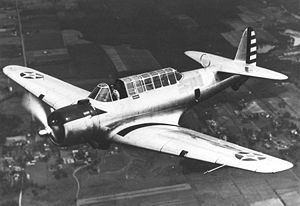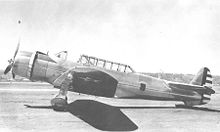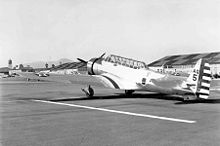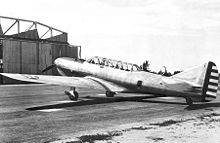Vultee A-19 Video - Picture

|
|
Vultee A-19
YA-19

Role: Ground attack
Manufacturer: Vultee
First flight: 27 January 1939
Introduced: 1939
Primary users: U.S. Army Air Corps
Brazilian Army Aviation
Number built: 216 (all variants)
The Vultee V-11 and V-12 were American attack aircraft of the 1930s. Developments of the Vultee V-1 single engined airliner, the V-11 and V-12 were purchased by several nation's armed forces, including China, who used them in combat against Japanese forces in the Second Sino-Japanese War. The United States Army Air Corps purchased small numbers of the V-11 as the Vultee YA-19 in the years before World War II, testing them to gather data to compare against twin engine light attack planes.
Design and development

Picture - Vultee YA-19 during tests
In 1935, Vultee produced a light bomber derivative of their single engined passenger transport, the Vultee V-1, which, while demonstrating good performance, was only sold in small numbers owing to competition from larger twin engined aircraft such as the Boeing 247 and Douglas DC-2 and increasing restrictions on the use of single engined aircraft for scheduled passenger transport operations.
The resulting aircraft, the Vultee V-11, retained the single engined, low wing format and all-metal stressed skin structure of the V-1. It combined a new fuselage with accommodation for the two or three crew members under a long canopy with the wings and tail surfaces of the Vultee V-1.
Operational history

Picture - Vultee YA-19 No.5, 17th Attack Group, March Field, California, 12 September 1939
China
An initial order for 30 two seat V-11Gs was placed by China before the end of 1935. This was followed by orders in 1939 for two versions (the V-12-C and V-12D) of the more powerful V-12 variant. The majority of these were planned to be assembled at the Central Aircraft Manufacturing Company factory at Loiwing near the China-Burma border, and while the first batch of 25 V-12-Cs were completed successfully, the factory was heavily bombed just after assembly of the first V-12-Ds commenced. This resulted in the part built airframes being evacuated to India, where it was planned that the aircraft be completed at the Hindustan Aircraft Limited factory in Bangalore. However, after a few were assembled, production was stopped as the factory was diverted to more urgent overhaul work.
The V-11s and V-12s that were available were used as light bombers to some limited success, including a mission to bomb the Japanese held airfield by 4 A-19's at Yuncheng on February 5, 1939 by the 10th Squadron of the Republic of China Air Force, before the aircraft were retired from frontline bombing missions to training and liaison duties in 1940.
Soviet Union
In 1936, the Soviet Union purchased a single three-seat V-11-GB aircraft, together with a production license. The aircraft entered Soviet production in 1937 as the BSh-1 (Bronirovanny Shturmovik), but the armour fitted for the ground attack role resulted in inadequate performance and production was stopped after 31 aircraft. They were redesignated PS-43 and transferred to Aeroflot, who used them as high speed transports until the Germany invasion in 1941, when they were returned to the Air Force who used them for liaison purposes.
United States
In the late 1930s, the United States Army Air Corps favored twin engine light attack aircraft but seven YA-19 aircraft were ordered in the summer of 1938 for comparison purposes. YA-19s were armed with six .30 in (7.62 mm) machine guns and 1,080 lb (490 kg) bombs in internal bomb bay, powered by a 1,200 hp (895 kW) Twin Wasp radial engine and was manned by a crew of three - pilot, observer/gunner, and bombardier/photographer.
An interesting feature of the YA-19 design was its horizontal stabiliser located entirely forwards of the vertical tail. The vertical stabilizer caused directional instability (yaw axis) due to undersize. The last YA-19 (S/N 38-555) was equipped with enlarged vertical stabilizer for improvement of directional stability but performance was not significantly improved.
Service test proved that twin engine attack aircraft had higher speed and carried more armament and larger bomb load. As a result no further YA-19s were ordered. After comparison tests five YA-19s were redesignated A-19 and assigned to the 17th Attack Group at March Field in California for a brief period. Later were transferred to the Panama Canal Zone for utility transport and liaison duties. The USAAC A-19 was never used in combat and was quickly replaced by more capable attack aircraft in the early 1940s.
Variants

Picture - Vultee YA-19A powered by Lycoming O-1230 engine
V-11
Two prototypes.
V-11-G
Original two seat light bomber. Powered by one 1,000 hp (746 kW) Wright R-1820-G2 Cyclone engine. 30 built for China.
V-11-GB
Three seat version of V-11. Single pattern aircraft purchased by Soviet Union, 40 by Turkey and 26 by Brazil.
BSh-1
Soviet licensed armoured ground attack version. Powered by 920 hp (686 kW) M-62. Production stopped after 31 built.
PS-43
BSh-1 after transfer to Aeroflot as light transport.
YA-19
Variant of V-11-GB for United states Army Air Corps. Five examples built.
YA-19A
One YA-19 was completed as an engine test bed. Equipped with enlarged vertical stabilizer (for improve directional stability) and powered by Lycoming O-1230 (12 cylinder opposed) engine.
YA-19B
One aircraft was fitted with Pratt & Whitney R-2800 radial engine as an engine test bed.
YA-19C
The YA-19A fitted with Pratt & Whitney Twin Wasp R-1830-51 engine. Performance was similar to the YA-19.
A-19
The remaining five YA-19 were redesignated A-19 after assignment to active duty.
V-12
Revised version of three seat bomber with refined aerodynamics and more power. One prototype flew in 1939 powered by Pratt & Whitney R-1830 Twin Wasp engine.
V-12-C
Production version of V-12 for China. Powered by R1820-G105B Cyclone engine. 26 built, one by Vultee and remaining 25 assembled in China.
V-12-D
Revised version with new fuselage and powered by 1,600 hp (1,190 kW) Wright R-2600 Cyclone 14 engine. 52 ordered for China, two pattern aircraft built by Vultee and 50 for local assembly.
Specifications (YA-19)
Data from USAF Museum
General characteristics
Crew: three
Length: 37 ft 10 in (11.53 m)
Wingspan: 50 ft 0 in (15.24 m)
Height: 10 ft 0 in (3.05 m)
Max takeoff weight: 10,420 lb (4,736 kg)
Powerplant: 1x— Pratt & Whitney R-1830-17 Twin Wasp 14 cylinder two row radial, 1200 hp (895 kW)
Performance
Maximum speed: 200 knots (230 mph, 370 km/h)
Range: 1,174 NM (1,350 mi, 2,174 km) ferry range
Service ceiling: 20,500 ft (6,250 m)
Armament
4 x forward-firing .30 calibre machine guns
1 x aft-firing .30 calibre machine gun
1 x ventral .30 calibre machine gun
1,080 lbs bombs in internal bay
Related development
Vultee V-1
Comparable aircraft
Fairey Battle
Northrop A-17
Bibliography
Donald, David (ed.). The Encyclopedia of World Aircraft. London: Aerospace, 1997. ISBN 1-85605-375-X.
Green, William and Swanborough, Gordon (eds.). "Those Versatile Vultees". Air Enthusiast. Volume 3 Number 1, July 1972. Pages 27-32, 38-42.
Vultee A-19 Pictures
Living Warbirds: The best warbirds DVD series.
Source: WikiPedia